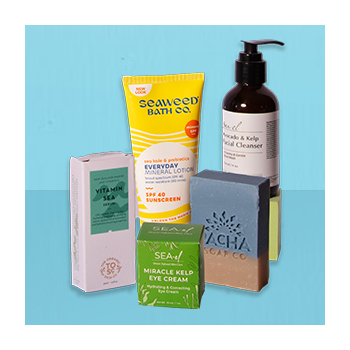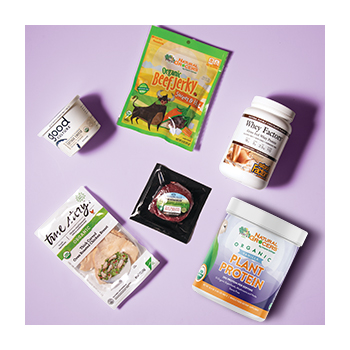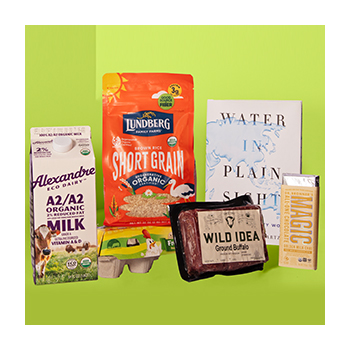


Sign-up for {N}power to get exclusive discounts, newsletters, members-only features, and more!

Natural Grocers' Nutrition Education team, consisting of health and wellness experts ranging from Registered Dietitians to Certified Natural Foods Chefs, collaborated with our purchasing and analytics team to study consumer shopping preferences and the latest research to predict these rising and shifting trends for 2025. Give one or more of these a try and see what works for you in 2025!


We all love a good life hack, and in 2025, we’ll hack our way to healthy blood sugar by incorporating science-backed tips and tricks into our daily routines. Having a pre-meal veggie snack, eating veggies and protein first during a meal, and drinking a glass of water spiked with apple cider vinegar or a whey protein shake 30 minutes before you eat are effortless hacks that support a healthy blood sugar response.1 2 3 Another evidence-based hack is doing two minutes of light physical activity—dancing, walking, or even a few squats all count—after you eat; moving your muscles shortly after eating encourages them to take up glucose for energy, which in turn, lowers blood sugar.4 Finally, incorporating blood sugar-balancing supplements like berberine and turmeric/curcumin has also been shown to be beneficial.5 6
Recognizing the significant impact that blood sugar has on overall health, these practices can help keep your blood sugar within a healthy range, leading to benefits like consistent energy, youthful skin, optimal fat burning, and healthy weight maintenance!

Rising up alongside the farm-to-table movement in the early 2000s, nose-to-tail eating—an approach to eating that uses the whole animal, including organs, skin, bones, and fats like lard and tallow—had its moment, but the fire fizzled, likely because most of us just weren’t used to eating organ meats and other “offal.” In 2025, this will change. We’ll see a resurgence of nose-to-tail eating, with an array of products on the shelves to make it easier—and more palatable.
Ancestral ground meat blends make it easy to dabble in nose-to-tail eating; these blends include nutrient-dense organ meats like heart and liver added to the ground meats we’re all familiar with, like ground beef, making them super easy to use in your favorite recipes. Using flavorful animal fats for cooking, sipping on nourishing bone broth, or noshing on pork rinds (just make sure they are high-quality from organically or regeneratively raised animals!) are all easy and delicious ways to incorporate nose-to-tail eating at home. Organ and collagen supplements are another easy way to incorporate this trend into your diet. These odd bits of offal provide a wealth of vital nutrients like the B vitamins, vitamins A, D, & E, choline, collagen, and glycine—many of which are lacking in the typical American diet, making nose-to-tail eating a modern-day must.

Mental health has come into sharp focus for just about everyone the last few years, and along with this, we’ve noted a growing body of research highlighting inflammation’s role in poor mental health, including anxiety and depression. We also know that inflammation drives overall poor brain function and has been linked to the development of degenerative diseases like Alzheimer’s and Parkinson’s.7 8 In 2025, we’re going to take a closer look at the diet, lifestyle, and environmental factors that contribute to excessive inflammation and will find ways to counteract it to foster emotional wellbeing and optimal brain function.
This will look like cutting back on ultra processed foods, refined carbohydrates, and sugar, and instead, focusing on balanced meals comprised of organic vegetables and fruit, healthy fats, humanely raised and sustainably sourced proteins, and fermented foods. It also means making time to enjoy physical activity, nurture meaningful relationships, and connect with nature—and understanding the collective impact these all have in managing inflammation. We’ll also get a helping hand from inflammation balancing and mood supportive supplements like vitamin D, turmeric/curcumin, and EPA and DHA.9 10 11


The way we choose deodorants is evolving in 2025, and we’re prioritizing products that not only help us tackle our underarm woes, but also champion our overall wellbeing. As a personal care staple that many of us use daily (sometimes multiple times a day), we’ve become increasingly mindful of the ingredients in our deodorants and their potential impact on health.
As a result, this year we’ll look to a new generation of “clean” deodorants for formulations made without ingredients like aluminum salts, parabens, phthalates, and artificial colors, fragrances, and preservatives. Instead, we’ll find ingredients like magnesium, which neutralizes odor, antimicrobial essential oils, odor-absorbing charcoal, and soothing (and antibacterial!) coconut oil. Although the switch might feel overwhelming at first, with a bit of patience and experimentation, we’ll find the perfect product, making the effort worth it for happy pits and vibrant health!

In 2024, more than half of US men used facial skincare products, a 68 percent increase from 2022.12 In 2025, we’ll continue to see this trend grow, as men move beyond traditional shaving and beard care to delve into the world of functional skincare to promote radiant, healthy skin. We’ll see a surge in products marketed toward men, including products like facial cleansers, exfoliators, serums, eye creams, and moisturizers that contain functional ingredients such as vitamin C, peptides, marine algae, and coffee extract. As men expand their dopp kits in 2025, they’ll also seek out products made with clean, natural, and responsibly sourced ingredients.

Body care is experiencing a tidal wave of ocean-inspired products, and we’re all on board! As we browse the body care aisles in 2025, we’ll discover a treasure trove of products infused with sea-based ingredients, from revitalizing sea salt and nutrient-rich extracts of seaweed, sea grapes, and sea kale to purifying sea clay, mud, and sand. Found in everything from soaps, lotions, bath salts, and body washes to facial cleansers, eye creams, serums, and blemish sticks, these oceanic wonders are being utilized in diverse ways to support healthy, radiant skin. Some touted benefits include promoting hydration, gently exfoliating and washing away impurities, and nourishing, soothing, and smoothing skin. Have fun diving into this trend and letting the sea transform your body care routine!


We know the importance of limiting sugar and passing on artificial sweeteners for our health, and now we’re becoming more mindful of another dietary concern: the overconsumption of high omega-6 “vegetable” oils like corn, sunflower, and soybean oils. Long hailed as “healthy” alternatives, these oils are anything but healthy.
Vegetable oils are high in omega-6 fats, which, when consumed in excess, shifts the body into an inflammatory state, which is associated as an underlying cause of everything from cardiovascular disease and poor mitochondrial function to negatively impacting weight management, skin and joint health, immunity, and brain function and mood.13 And these oils are ubiquitous—in our homes, in restaurants, in fast food, and in ultra processed foods—with some sources suggesting that they account for up to 20 percent of the average American’s total calorie intake.14
In 2025, we will rethink our cooking oils, with a focus on supporting a better balance of omega-6 to omega-3 fats. This means swapping out high omega-6 oils for healthier, traditional fats like extra virgin olive oil, coconut oil, avocado oil, lard, and butter or ghee. We’ll also reduce our ultra processed food intake, increase our intake of anti-inflammatory omega-3-rich foods like wild salmon, sardines, and 100% grass-fed beef, and incorporate fish and algal oil supplements to optimize our omega-3 levels.

Everyone’s buzzing about protein right now. Just check out TikTok, where nearly 1.5 million posts featured the hashtag #protein in August 2024. Protein helps us feel full, balances blood sugar, and curbs cravings, making it key for healthy weight management. It’s also critical for muscle growth, repair, and recovery, which becomes especially imperative as we get older to keep us strong, independent, and physically active. Additionally, neurotransmitters—the chemical messengers used by our brains to process thoughts, feelings, and information—are made out of protein.
That’s why, in 2025, we’ll focus on including plenty of protein in each meal (a palm-sized portion is adequate), and because we know quality matters, we will choose humanely raised and sustainably sourced animal proteins, like regeneratively raised and 100% grass-fed beef and antibiotic-free pork, organic poultry, pasture-based eggs, and wild-caught fish. When choosing plant-based protein options like nuts and seeds, beans and legumes, and tempeh and tofu, we’ll make sure it is organic, because we care about leaving a livable planet for future generations. We’ll also incorporate organic and grass-fed protein powders, jerky, meat sticks, and protein bars as delicious and convenient snack options.
- Natural Grocers Brand Organic Teriyaki Beef Jerky
- Natural Factors Whey Factors Chocolate Grass Fed Whey Protein
- Natural Grocers Brand Organic Vanilla Plant Protein
- Thousand Hills Regenerative 100% Grassfed Beef Top Sirloin Steak
- True Story Organic Sliced Thick-carved Oven-roasted Chicken Breast
- Good Culture Organic Whole Milk Classic Cottage Cheese

There’s a growing appetite to experience authentic international flavors and dishes right at home, whether it’s for the thrill of honing our culinary skills, discovering new flavors, or reaping the health benefits of diverse cuisines, many are eager to experiment with global recipes in their own kitchens.
Embracing this trend in 2025, grocery aisles will transform into a culinary adventure, offering a world of authentic international flavors right at our fingertips. We’ll spice up organic produce, lentils, grains, and meats with global seasonings like harissa, turmeric, cumin, and Chinese five spice. We’ll savor an array of flavorful sauces, soups, and noodle dishes, including zesty Thai curries, bold and creamy tikka masala, comforting miso soup, and savory ramen. With options ranging from dumplings and sushi to paella, posole, and pad Thai, the variety of dishes to try is endless. The growing selection of ready-made, internationally-inspired products crafted with good4u ingredients will make it easier than ever to experience authentic flavors and cuisines, turning everyday meals into a delightful journey around the globe!


With rising concerns about climate change, soil degradation, and nutrient loss in our food, it's encouraging to see regenerative agriculture gaining momentum. This movement aims not only to sustain, but to improve soil quality and health, ecosystem health, animal welfare, and human health, while advancing fairness for farmers and farm workers.
However, the term "regenerative" remains new and unregulated, lacking a universal definition. This often leads to ambiguity when the term is applied to products and used in marketing, which can pave the way for greenwashing, especially by large companies eager to capitalize on the trend. These companies may advertise their products and techniques as “regenerative,” but they frequently continue practices that harm the environment without making meaningful improvements to the land. This not only misleads consumers, but undermines those who are genuinely committed to adopting regenerative practices and enhancing environmental, social, and human wellbeing.
In light of this, consumers will enter the fight in 2025, and will help define regenerative agriculture by supporting truly regenerative practices. We will seek out products with certifications like the Regenerative Organic Certification from the Regenerative Organic Alliance, and the Land to Market Verified Regenerative label from the Savory Institute, which provide criteria and benchmarks for genuine regenerative practices and call for proof of outcomes. We will also educate ourselves through resources like the Rodale Institute and books like Cows Save the Planet by Judith Schwartz, enabling us to drive meaningful change and win the battle to define regenerative.

Just as regenerative and organic farmers will work to build soil and ecosystem health, we too will go on a mission to make our own patios, yards, and gardens thrive! We’ll dig into using organic fertilizers and organic compost, we’ll plant cover crops and pollinator-loving native plants, and spread natural mulch to keep the soil vibrant and healthy by boosting organic matter, microbial life, and water retention.
Since a whopping third of our food relies on the vital work of pollinators, we’ll also commit to creating inviting outdoor havens that support their wellbeing and encourage biodiversity.16 We’ll take the Natural Grocers® Ladybug Love pledge to avoid using synthetic pesticides that harm these beneficial insects. We’ll also choose organic seeds and use natural weed control methods like hand weeding, mulching, and more pollinator friendly vinegar-based weed sprays.
We’ll also plant pollinator gardens (or container gardens if you’re short on space) and set up water sanctuaries to help them thrive. We’ll embrace less intensive lawn care approaches like No Mow May or Slow Mow Summer to provide much-needed food and shelter for our pollinator pals. Knowing that these small efforts lead to significant impacts, we’re excited to roll up our sleeves and turn our yards and gardens into a buzzing success.

In 2025, we’ll not only give our homes a thorough spring clean, but will address PFAS, or per- and polyfluoroalkyl substances. Dubbed “forever chemicals” because they stick around in the environment for, well, forever, these man-made substances are used in a variety of household items to make them more durable, stain- and grease-resistant, waterproof, and non-stick. Due to their widespread use, PFAS can sneak into our homes via furniture, wall paint, mattresses, rugs, non-stick cookware, waterproof clothing, electronics, cleaning products, tap water, and everyday products like dental floss and paper goods. This is a sobering thought, considering exposure to high amounts of these chemicals is linked with a long list of negative health effects in both humans and animals.17
In 2025 and beyond, we'll be more mindful of PFAS in our homes, prioritizing products labeled as PFAS-free, especially cleaning and personal care items and paper goods. We’ll swap out non-stick pans for stainless steel, cast iron, glass, or ceramic options, and give our water a fresh start with reverse osmosis and activated charcoal filters. We’ll also be cautious of stain-resistant and waterproof fabrics and won’t underestimate the power of a little dusting, because who knew those dust bunnies could be hiding PFAS too!

Preserving and nurturing biodiversity will become increasingly significant this year. Referring to the variety of life on earth, from tiny microbes and diverse animal and plant species to our own genetic makeup, robust biodiversity is crucial for ecosystem stability, resilience, and the provision of ecosystem services such as clean air, water, and soil fertility. It underpins the health of our planet and enhances human wellbeing, even benefiting our mental health, as one study found.18 Yet, biodiversity faces mounting threats from industrial agriculture, rapid urbanization, deforestation, pollution, and climate change, and is on the decline.19
Considering what life would be like without biodiversity, we will take decisive action in 2025 to protect it, recognizing its remarkable resilience and potential to recover with a bit of care. Whether it’s opting for organic food, supporting conservation initiatives, or tending to our own backyards and community green spaces, no action will be too small. We’ll find when we all work together, we can make a significant difference in fostering a thriving and diverse world.



Sign-up for {N}power to get exclusive discounts, newsletters, members-only features, and more!